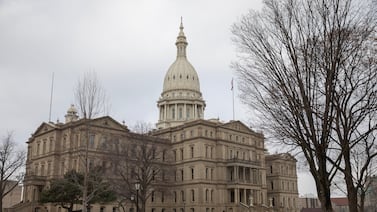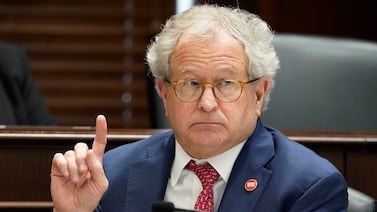Sign up for Chalkbeat New York’s free daily newsletter to get essential news about NYC’s public schools delivered to your inbox.
Just two days before the deadline, a group of education advocates on Thursday urged city officials to request a pause to state law that requires New York City to sharply reduce class sizes.
They contend a pause could allow incoming Mayor Zohran Mamdani to address a central inequity: The city’s highest-need schools stand to benefit the least from mandatory class size caps.
All of the city’s public schools must cap class sizes at 20-25 students, depending on grade level, by 2028. City officials expected 60% of classrooms across the city would meet the caps this year, as required by law, largely by hiring more teachers.
Next year’s 80% benchmark will be a much bigger challenge. Many campuses don’t have space for smaller classes without capping enrollment, a nonstarter with many families. And building new classrooms is expensive and time-consuming. The city is allowed to request school-level exemptions to the law, though they must be approved by union officials.
A provision of the law gives city officials an opportunity to “recommend a pause of the class size reduction plan” — a request that must be made as part of a financial impact statement due Nov. 15. State officials can withhold funding if the city Education Department fails to comply with the law.
“The bottom line is that this well-intentioned mandate will transfer resources — money, teachers, and buildings — from the schools that need them the most to the schools that need them the least,” said Richard Buery, the CEO of the Robin Hood Foundation and a former deputy under Mayor Bill de Blasio. He was joined at a Thursday press conference by advocates from EdTrust-New York and Educators for Excellence.
Buery said it is the “wrong time” to focus on system-wide class size reductions given threats from the Trump administration to slash federal funding and as city officials are receiving less money from the state than expected.
Others stressed that a pause would allow Mamdani to negotiate a plan with the state legislature to implement the law more equitably. It would not prevent him from continuing to lower class sizes, they added.
“He could also make the decision to use some of this money to reduce class size in a few communities or a few grade levels, and use other resources to support his other ambitious goals around early childhood,” said Evan Stone, CEO of Educators for Excellence, a teacher advocacy group.
It’s unclear whether Mamdani would support such a move, and a spokesperson did not respond to a request for comment. The mayor-elect has repeatedly said he supports the class size law and campaigned on a plan to ramp up teacher hiring to comply with it.
Tension over benefits and tradeoffs of class size law
Smaller classes are popular among many educators and families. The city’s teachers union, which endorsed Mamdani, lobbied fiercely for the law, arguing small classes are essential to learning and can help attract educators to the profession. Studies suggest that students learn more in small classes and that those from low-income families tend to benefit the most.
But in practice, the class size mandate has significant tradeoffs. Because the city’s highest-poverty schools generally have smaller classes, they are least likely to benefit from the new cap, a Chalkbeat analysis found. That will require the city to spend resources on campuses that are relatively more affluent and may divert funding that school leaders could have used for other programs.
Union officials counter that the majority of students who will experience smaller classes come from low-income families, as they are the vast majority of students in city schools. United Federation of Teachers President Michael Mulgrew criticized the push to delay implementing the law.
“They claim to work on behalf of students and families in poverty, yet they seek to derail an initiative that prioritizes high-need schools,” Mulgrew said in a statement. “There is no reason to pause. This initiative is working.”
Even as union officials noted the city is required to prioritize high-need schools first, the law mandates that the class size caps apply to all schools by 2028 regardless of student poverty levels.
Advocates also warned that the teacher hiring spree could exacerbate turnover at higher-poverty schools. A chunk of the new educators required to staff smaller classes are likely to be drawn from needy schools, an analysis from the Urban Institute think tank found. Better-off schools will have to ramp up hiring and often are perceived as more desirable teaching assignments.
City mum on whether to request a pause
The city’s Education Department declined to say whether it will ask for a pause as part of a broader class size financial impact statement due Saturday. A spokesperson said only they will have more to share soon.
As part of the report, city officials are expected to reveal what percentage of classes are in compliance with the law. Last school year, nearly 47% of classes complied with the new caps, above the 40% required.
Mayor Eric Adams’ administration has previously criticized the class size law, arguing that state officials did not commit to sending the city funding to cover it. The annual cost of hiring more than 10,000 new teachers that are expected to staff smaller classes is between $1.3 billion and $1.9 billion, according to the Education Department and Independent Budget Office (not including additional school construction costs which could cost tens of billions more in the long run).
After failing to block the law, Adams has vowed to comply with it.
If the Education Department does request a pause, advocates said it will fall to state education Commissioner Betty Rosa to sign off. (A spokesperson for Rosa did not confirm that power will fall to her and the law does not explicitly say.) Rosa has previously expressed her own concerns about the class size law, noting it will not benefit all schools equally.
“You’re gonna have to take it from Peter to give it to Paul,” she previously said.
Alex Zimmerman is a reporter for Chalkbeat New York, covering NYC public schools. Contact Alex at azimmerman@chalkbeat.org.





